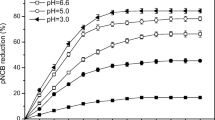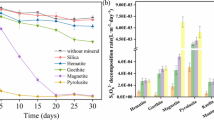Abstract
Persulfate-based advanced oxidation processes (PS-AOPs) have emerged as a highly promising approach for remediating organic-contaminated soil. However, the substantial cost associated with the large injection volume of persulfate and the potential ecological risks arising from sulfate accumulation in the post-remediated soil have hindered the widespread application of this technology. To address these challenges, this study proposed a novel and environmental-friendly approach based on the reversible regeneration of ammonium persulfate (APS) through electrochemical synthesis, with the aim of realizing cyclic utilization of APS. Through our in-depth investigation, we have scrutinized the performance and kinetic behaviors of Fe2+-APS in the remediation of organic-contaminated soil, utilizing NAP as the target. By identifying the decisive factors for electrochemical regeneration of APS, we have also unraveled the underlying mechanisms governing the electrochemical synthesis of APS. Experimental results demonstrate an impressive degradation rate of 76.39% of naphthalene (NAP) in contaminated soil through Fe2+-APS remediation with the optimal parameter (voltage of 8 V, flow velocity of 10 mL/min, ammonium sulfate concentration of 3 M). Moreover, our dynamic electrochemical devices significantly outperform the static setup in terms of regeneration of APS, with the concentration and current efficiency achieving 75 and 20 times higher, respectively. Notably, the NAP degradation rate in the soil remains at a commendable 75% even after five cycles, thereby validating the practicality and efficacy of this approach. This innovative approach provides both theoretical and practical foundations to advance the development and adoption of persulfate-based technologies in soil remediation efforts.









Similar content being viewed by others
Data availability
The data are available upon request by contacting lcshirley@163.com (Chen Li).
Abbreviations
- PS-AOPs:
-
Persulfate-based advanced oxidation processes
- APS:
-
Ammonium persulfate
- NAP:
-
Naphthalene
- HPLC:
-
High-performance liquid chromatograph
- ACE:
-
The average current efficiency
References
Abahussain AA, de Leon CP, Walsh FC (2018) Mass-transfer measurements at porous 3D Pt–Ir/Ti electrodes in a direct borohydride fuel cell. J Electrochem Soc 165(3):198–206
Abelson PH (1992) Remediation of hazardous waste sites. Science 255:901–901
Alharbi OML, Basheer AA, Khattab RA, Ali I (2018) Health and environmental effects of persistent organic pollutants. J Mol Liq 263:442–453
Anipsitakis GP, Dionysiou DD (2004) Radical generation by the interaction of transition metals with common oxidants. Environ Sci Technol 38:3705–3712
Aparicio JD, Raimondo EE, Saez JM et al (2022) The current approach to soil remediation: a review of physicochemical and biological technologies, and the potential of their strategic combination. J Environ Chem Eng 10:107141
Cao Y, Yuan X, Zhao Y, Wang H (2022) In-situ soil remediation via heterogeneous iron-based catalysts activated persulfate process: a review. Chem Eng J 431:133833
Chen Z (2011) Study on preparation of ammonium persulfate by electrolytic ammonium sulfate solution. North Environ 23:76–79 (In Chinese)
Cong Y, Xiao G, Qiao Q, Zhang J, Li P (2001) Electrochemical preparation of ammonium persulfate by dilute solution of ammonium sulfate. J Liaoning Shihua Univ 04:29–31 (In Chinese)
Dror I, Yaron B, Berkowitz B (2022) The human impact on all soil-forming factors during the anthropocene. ACS Environ Au 2:11–19
Du X, Zhang Y, Hussain I, Huang S et al (2017) Insight into reactive oxygen species in persulfate activation with copper oxide: activated persulfate and trace radicals. Chem Eng J 313:1023–1032
FAO (Food and Agriculture Organization), UNEP (United Nations Environment Programe) (2021) Global assessment of soil pollution: Report. https://www.fao.org/3/cb4894en/online/cb4894en.html. Accessed 9 Sep 2023
Feng H, Xiong Y, Wu B (2017) Electrochemical production of ammonium persulfate using absorption solution from ammonia-based desulfurization and denitrification. CIESE J 68:4697–4701 (In Chinese)
Gao HY, Huang CH, Mao L, Shao B, Shao J, Yan ZY, Tang M, Zhu BZ (2020) First direct and unequivocal electron spin resonance spin-trapping evidence for pH-dependent production of hydroxyl radicals from sulfate radicals. Environ Sci Technol 54:4046–14056
Huang KC, Zhao Z, Hoag GE et al (2005) Degradation of volatile organic compounds with thermally activated persulfate oxidation. Chemosphere 61:551–560
Jin X, Yu B, Lin J, Chen Z (2016) Integration of biodegradation and nano-oxidation for removal of PAHs from aqueous solution. ACS Sustain Chem Eng 4:4717–4723
Lee J, von Gunten U, Kim JH (2020) Persulfate-based advanced oxidation: critical assessment of opportunities and roadblocks. Environ Sci Technol 54:3064–3081
Lei YJ, Tian Y, Fang C, Zhan W, Duan LC, Zhang J, Zuo W, Kong XW (2019) Insights into the oxidation kinetics and mechanism of diesel hydrocarbons by ultrasound activated persulfate in a soil system. Chem Eng J 378:122253
Liang J, Liu H, Zou M, Tao X, Zhou J, Dang Z, Lu G (2023) Degradation efficiency and mechanism of 2,2′,4,4′-tetrabromodiphenyl ether (BDE-47) by thermally activated persulfate system. Chemosphere 325:138396
Long Y, Wu Z, Ding X, Chen J, Shen D, Shentu J, Hui C (2024) Potential risks of organic contaminated soil after persulfate remediation: harmful gaseous sulfur release. J Environ Sci 135:1–9
Lu M, Zhang Z, Qiao W, Guan Y, Xiao M, Peng C (2010) Removal of residual contaminants in petroleum-contaminated soil by Fenton-like oxidation. J Hazard Mater 179:604–611
Matzek LW, Carter KE (2016) Activated persulfate for organic chemical degradation: a review. Chemosphere 151:178–188
MLR (Ministry of Environmental Protection), MEP (Ministry of Land and Resources) (2014) National Survey on Soil Pollution: report. https://www.gov.cn/foot/site1/20140417/782bcb88840814ba158d01.pdf. Accessed 9 Sep 2023
Nan H, Wang X (2013) Application of EPEEK composite membrane in electrosynthesis of ammonium persulfate. Chem Ind Eng 30:53–58 (In Chinese)
Qu Y, Cui M, Zhang C, Li C, Li P, Ren J (2021) Study on improve the production of ammonium persulfate by ion membrane electrolysis. J Electrochem 27:586–592 (In Chinese)
UN (United Nations) (2019) World Urbanization Prospects: The 2018 Revision. https://population.un.org/wup/Publications/Files/WUP2018-Report.pdf. Accessed 9 Sep 2023
Wang C, Zhou J, Gao L (2018) Experimental study on four cation exchange membranes in electrosynthesis of ammonium persulfate. J Electrochem Sci Technol 9:37–43
Xiang L, Harindintwali JD, Wang F et al (2022) Integrating biochar, bacteria, and plants for sustainable remediation of soils contaminated with organic pollutants. Environ Sci Technol 56:16546–16566
Yan DY, Lo IM (2013) Removal effectiveness and mechanisms of naphthalene and heavy metals from artificially contaminated soil by iron chelate-activated persulfate. Environ Pollut 178:15–22
Zeng H, Liu S, Chai B, Cao D, Wang Y, Zhao X (2016) Enhanced photoelectrocatalytic decomplexation of Cu–EDTA and Cu recovery by persulfate activated by UV and cathodic reduction. Environ Sci Technol 50:6459–6466
Zhao W, Xing J, Chen D, Bai Z, Xia Y (2015) Study on the performance of an improved Ti/SnO2–Sb2O3/PbO2 based on porous titanium substrate compared with planar titanium substrate. RSC Adv 5:26530–26539
Zhao W, Xing J, Chen D, Jin D, Shen J (2016) Electrochemical degradation of musk ketone in aqueous solutions using a novel porous Ti/SnO2–Sb2O3/PbO2 electrodes. J Electroanal Chem 775:179–188
Zhou Z, Liu X, Sun K, Lin C, Ma J, He M, Ouyang W (2019) Persulfate-based advanced oxidation processes (AOPs) for organic-contaminated soil remediation: a review. Chem Eng J 372:836–851
Zhou J, Wu Y, Wang C, Gao L (2020) Comparison of electrosynthesis of ammonium persulfate by membrane electrolytic cells with shared catholyte and with separate catholyte. Electrochemistry 88(4):268–275
Zhu J, Hii KK, Hellgardt K (2016) Toward a green generation of oxidant on demand: practical electrosynthesis of ammonium persulfate. ACS Sustain Chem Eng 4:2027–2036
Zhu X, Sun W, Li C, Wang Z, Cui X, Li B, Tian S (2023) Generation, activation, and recycling of ammonium persulfate for the remediation of organic-contaminated soil: system construction, process, and mechanisms. Chem Eng J 471:144482
Acknowledgements
All authors gratefully acknowledge the financial support of the National Natural Science Foundation of China (22106056).
Author information
Authors and Affiliations
Contributions
All authors contributed to this work. X.C. was contributed to methodology, formal analysis, writing—original draft, writing—review and editing; W.S and Z.W. were contributed to data curation, formal analysis; X.Z., X.S and S.C. were contributed to experimental data; C.L was contributed to conceptualization and supervision, writing—review and editing. B.L. and S.T were contributed to writing—review and editing. All authors have read and agreed to the published version.
Corresponding author
Ethics declarations
Conflict of interest
All authors declare no known competing financial interests or personal relationships that could have appeared to influence the work reported in this article.
Additional information
Editorial responsibility: S. Mirkia.
Rights and permissions
Springer Nature or its licensor (e.g. a society or other partner) holds exclusive rights to this article under a publishing agreement with the author(s) or other rightsholder(s); author self-archiving of the accepted manuscript version of this article is solely governed by the terms of such publishing agreement and applicable law.
About this article
Cite this article
Cui, X., Sun, W., Wang, Z. et al. Simulated study on electrochemical regeneration of ammonium persulfate for naphthalene degradation in soil. Int. J. Environ. Sci. Technol. (2024). https://doi.org/10.1007/s13762-024-05596-7
Received:
Revised:
Accepted:
Published:
DOI: https://doi.org/10.1007/s13762-024-05596-7




